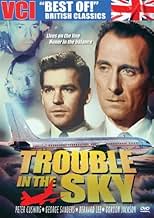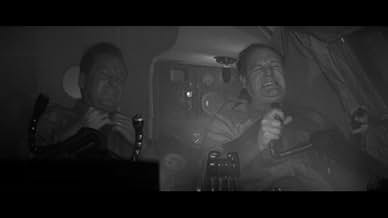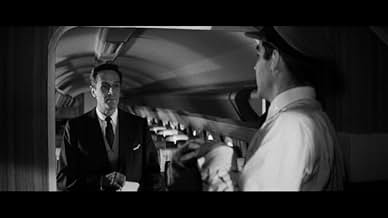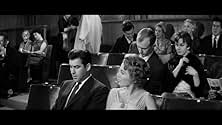AVALIAÇÃO DA IMDb
6,5/10
469
SUA AVALIAÇÃO
Adicionar um enredo no seu idiomaIn Britain, at the dawn of jet-powered commercial aviation, an aircraft manufacturer tries to shift the blame from mechanical failure to pilot error when its newest jet airliner has a series... Ler tudoIn Britain, at the dawn of jet-powered commercial aviation, an aircraft manufacturer tries to shift the blame from mechanical failure to pilot error when its newest jet airliner has a series of accidents.In Britain, at the dawn of jet-powered commercial aviation, an aircraft manufacturer tries to shift the blame from mechanical failure to pilot error when its newest jet airliner has a series of accidents.
- Direção
- Roteiristas
- Artistas
André Morell
- Capt. Manningham
- (as Andre Morell)
Charles 'Bud' Tingwell
- Capt. Braddock
- (as Charles Tingwell)
- Direção
- Roteiristas
- Elenco e equipe completos
- Produção, bilheteria e muito mais no IMDbPro
Avaliações em destaque
As a former BOAC pilot David Beaty certainly knew his stuff and must surely have been pleased with this adaptation of his novel.
Has the crash of a jetliner flown by Captain Gort in which a co-pilot is killed been caused by a design fault or pilot error? That is the question. Although the captain is hung out to dry by a clever lawyer representing the airline at the tribunal of investigation he is still allowed to fly. As the film progresses it becomes clear that the aircraft designer has not been entirely forthcoming......
Charles Frend is a capable, workmanlike director and has done a good job here with a limited budget and some excellent actors. This was made at a time when there was a wealth of first class English actors upon which to draw. Peter Cushing and Andre Morell were no strangers to each other and had recently played Sherlock Holmes and Dr. Watson. I consider Morell to be a superlative Watson and arguably the best Quatermass. Here Cushing has the showiest part and exhibits his customary style. This film can only work of course if the character of Captain Gort is sympathetic and here the casting of Bernard Lee is inspired. He achieves so much by doing so little. George Sanders is as always immaculate and although he only has two scenes as the lawyer Sir Arnold, undoubtedly pocketed the biggest salary.
It comes as no surprise that the airborne scenes are the most effective and that in which Lee and his crew hit a freak hailstorm is especially gripping.
The culpability of a pilot for an airline disaster was to be depicted in Ralph Nelson's excellent 'Fate is the Hunter' of 1964. Whilst Frend's film has neither the production values nor the starry cast of the later film, it still manages in its own quiet way to pack quite a punch.
Has the crash of a jetliner flown by Captain Gort in which a co-pilot is killed been caused by a design fault or pilot error? That is the question. Although the captain is hung out to dry by a clever lawyer representing the airline at the tribunal of investigation he is still allowed to fly. As the film progresses it becomes clear that the aircraft designer has not been entirely forthcoming......
Charles Frend is a capable, workmanlike director and has done a good job here with a limited budget and some excellent actors. This was made at a time when there was a wealth of first class English actors upon which to draw. Peter Cushing and Andre Morell were no strangers to each other and had recently played Sherlock Holmes and Dr. Watson. I consider Morell to be a superlative Watson and arguably the best Quatermass. Here Cushing has the showiest part and exhibits his customary style. This film can only work of course if the character of Captain Gort is sympathetic and here the casting of Bernard Lee is inspired. He achieves so much by doing so little. George Sanders is as always immaculate and although he only has two scenes as the lawyer Sir Arnold, undoubtedly pocketed the biggest salary.
It comes as no surprise that the airborne scenes are the most effective and that in which Lee and his crew hit a freak hailstorm is especially gripping.
The culpability of a pilot for an airline disaster was to be depicted in Ralph Nelson's excellent 'Fate is the Hunter' of 1964. Whilst Frend's film has neither the production values nor the starry cast of the later film, it still manages in its own quiet way to pack quite a punch.
Airline pilot Bernard Lee is downgraded for 'pilot error', and eventually reinstated at full rating. His daughter, Elizabeth Seal, knows him for a by-the-book sort of man and puts a bug in the ear of pilot tester Michael Craig. He begins to suspect that the problem lies not in the pilot, but in the new jet plane; the company that manufactures it prefers to blame the man, rather than lose out in a hotly contested, lucrative market.
The movie is suggested by some issues in the De Havilland comet, the first commercial jet liner, in the early 1950s. Jet aviation was a hot topic for the movies, and NO HIGHWAYS IN THE SKY was on the film makers' minds as a likely model. All of the pilots start out being by-the-book, but their individual characters, both as men and pilots, come gradually to the fore, with Gordon Jackson (whose character is called, ineviltably, 'Jock') speaking offhandedly of instinct. In the meantime, we are confronted by everyone except Craif and Miss Seal, being walking avatars of professional probity, from George Sanders, who asks the correct questions at hearings, to Peter Cushing , who demands a retest of Lee .... and who is shocked to learn that he may have been guilty of a near-accident .... missed, like many, it is suggested, by sheer luck.
It's interesting to see in the cast so many actors who spent their careers playing villains. Instead they are tightly repressed. It's an interesting, coolly intellectualized movie that pits man and experience against the sleek, mechanized world we were moving into in the 1950s. The only strike against it is its lack of overt excitement around a now outmoded tecnology. Perhaps the modern audience would find it as relevant as a movie about steam automobiles that keep exploding. On the other hand, recent news about the Boeing 737 may make it telling.
The movie is suggested by some issues in the De Havilland comet, the first commercial jet liner, in the early 1950s. Jet aviation was a hot topic for the movies, and NO HIGHWAYS IN THE SKY was on the film makers' minds as a likely model. All of the pilots start out being by-the-book, but their individual characters, both as men and pilots, come gradually to the fore, with Gordon Jackson (whose character is called, ineviltably, 'Jock') speaking offhandedly of instinct. In the meantime, we are confronted by everyone except Craif and Miss Seal, being walking avatars of professional probity, from George Sanders, who asks the correct questions at hearings, to Peter Cushing , who demands a retest of Lee .... and who is shocked to learn that he may have been guilty of a near-accident .... missed, like many, it is suggested, by sheer luck.
It's interesting to see in the cast so many actors who spent their careers playing villains. Instead they are tightly repressed. It's an interesting, coolly intellectualized movie that pits man and experience against the sleek, mechanized world we were moving into in the 1950s. The only strike against it is its lack of overt excitement around a now outmoded tecnology. Perhaps the modern audience would find it as relevant as a movie about steam automobiles that keep exploding. On the other hand, recent news about the Boeing 737 may make it telling.
1960's "Trouble in the Sky" (British title "Cone of Silence") is an excellent airplane drama featuring as fine a cast as could be found in British films that year. At the center of it all is future 'M' in the James Bond series, Bernard Lee as Captain George Gort, who is found guilty of pilot error after a recent crash of the new Phoenix resulted in the death of his co-pilot. Captain Edward Manningham (Andre Morell) leaves Gort's fate in the judgment of examiner Hugh Dallas (Michael Craig), whose subsequent test is passed with flying colors, enabling Gort to continue his career, having logged more miles in the air than all the other pilots combined. One such pilot is Captain Clive Judd (Peter Cushing), who believes in Gort's guilt, conspiring to undermine him and have him reassigned to a ground position. Gort's rock solid convictions are so trustworthy that we too believe him to be innocent of any negligence, so it's quite a shock when similar circumstances result in an identical crash, this time killing the dedicated pilot. By now, Dallas too is convinced that the fault lies elsewhere, with the comeuppance of the arrogant Judd a key factor in finding the truth. Based on the actual 1953 case of the DeHavilland Comet, Britain's first passenger jet airliner, the remainder of the cast comes off like a Who's Who of vintage 60s cinema: Gordon Jackson, Charles Tingwell, Noel Willman, Marne Maitland, Jack Hedley, Charles Lloyd Pack, Anthony Newlands, Gerald Sim, and Geoffrey Bayldon. Of special mention is the supporting presence of George Sanders, coming off the heroic "Village of the Damned" and the villainous "Bluebeards Ten Honeymoons," here in more typical form as smarmy attorney Sir Arnold Hobbes, his damning courtroom highjinks convicting the innocent Gort. As for second-billed Peter Cushing, he makes just one appearance before the film's second half, beginning a string of nine consecutive non genre features in a failed effort to avoid the horror typecasting that Christopher Lee also feared.
In the set CUSHING CURIOSITIES, there are 5 feature films and the 6 remaining episodes of the BBC's SHERLOCK HOLMES series from 1968. The movies were made between 1959 and 1974 and reflect not only the growth of Cushing's career but the many changes in society and the movie industry that brought about the end of the Gothic horror films in which he specialized. Three of the films are in black and white. SUSPECT (1960) and THE MAN WHO FINALLY DIED (1962) have pre-James Bond espionage themes. CONE OF SILENCE, based on a book, deals with faulty aircraft design and is based on fact.
In SUSPECT, Cushing plays a scientist who wishes to publish his findings on deadly bacteria while the British Government wants them withheld from public knowledge. The film co-stars Donald Pleasance and Ian Bannen. In THE MAN WHO FINALLY DIED, Cushing is an ex-Nazi who is trying to commit insurance fraud...or is he? Headlining the movie is Stanley Baker, just 2 years away from international stardom in ZULU. Baker plays a man who is shocked to discover that his German father (not Cushing), whom he thought was long dead, is still alive. Both movies are tense and terse.
The earliest movie in the set, CONE OF SILENCE, dates from 1959. It tells the story of a new line of airplanes that sometimes crash while attempting to land. Peter is an ambitious pilot who, in order to advance his career, blames the crashes on an older cohort rather than the structural flaw he knows to be the real cause. The film has a strong cast that includes George Sanders and Bernard Lee. Future Hammer regulars Andre Morell and Marne Maitland have significant supporting roles. As stated earlier, the screenplay is based on fact.
The other two films, BLOODSUCKERS and TENDER DRACULA are both in color, made in the early 1970s and were barely released. The first movie, about modern day vampires, suffered from producer interference resulting in the director having his name removed. It also underwent several name changes. I first saw it in a drive-in and it wasn't half bad. In addition to Cushing, it has the added presence of Patrick Macnee and Edward Woodward. The 10 minute LSD induced orgy scene, which caused the director to leave and was ultimately cut, has been restored here. .. SPOILER ALERT!... It adds absolutely nothing to the film.
TENDER DRACULA is a real oddity. It was made in France in 1974 and, aside from Cushing and THE THIRD MAN star Alida Valli, features an all French cast and crew. It was intended to be a combination horror comedy and sex farce and how well it succeeds will depend on your taste for...French horror comedies / sex farces. It does have its admirers but only in France which is the only place it was released before going straight to video. Whether it is Cushing's worst movie is debatable. He didn't think so, giving that distinction to 1967's THE BLOOD BEAST TERROR, but TD gets my vote.
As for the 6 SHERLOCK HOLMES episodes, they prove that Peter Cushing was one of the great Holmes interpreters right up there with Jeremy Brett and Basil Rathbone. His lean, gaunt features, dismissive attitude, and nervous energy are very close to Doyle's description of the character. Cushing also insisted that his wardrobe match the illustrations from the Victorian period magazines where Holmes first appeared. Nigel Stock is the perfect Dr. Watson. An ordinary man who helps to ground his extraordinary friend. Of the stories, only A STUDY IN SCARLET disappoints as the murderer's background has been eliminated.
So, in the final summary, CUSHING CURIOSITIES is a must for all fans of the actor even if not all the material is first rate. It gives us a chance to see Peter in some of his solid supporting roles before he became a horror star and some lesser known movies that he made to keep himself busy after his wife died in 1971... For more reviews visit The Capsule Critic.
In SUSPECT, Cushing plays a scientist who wishes to publish his findings on deadly bacteria while the British Government wants them withheld from public knowledge. The film co-stars Donald Pleasance and Ian Bannen. In THE MAN WHO FINALLY DIED, Cushing is an ex-Nazi who is trying to commit insurance fraud...or is he? Headlining the movie is Stanley Baker, just 2 years away from international stardom in ZULU. Baker plays a man who is shocked to discover that his German father (not Cushing), whom he thought was long dead, is still alive. Both movies are tense and terse.
The earliest movie in the set, CONE OF SILENCE, dates from 1959. It tells the story of a new line of airplanes that sometimes crash while attempting to land. Peter is an ambitious pilot who, in order to advance his career, blames the crashes on an older cohort rather than the structural flaw he knows to be the real cause. The film has a strong cast that includes George Sanders and Bernard Lee. Future Hammer regulars Andre Morell and Marne Maitland have significant supporting roles. As stated earlier, the screenplay is based on fact.
The other two films, BLOODSUCKERS and TENDER DRACULA are both in color, made in the early 1970s and were barely released. The first movie, about modern day vampires, suffered from producer interference resulting in the director having his name removed. It also underwent several name changes. I first saw it in a drive-in and it wasn't half bad. In addition to Cushing, it has the added presence of Patrick Macnee and Edward Woodward. The 10 minute LSD induced orgy scene, which caused the director to leave and was ultimately cut, has been restored here. .. SPOILER ALERT!... It adds absolutely nothing to the film.
TENDER DRACULA is a real oddity. It was made in France in 1974 and, aside from Cushing and THE THIRD MAN star Alida Valli, features an all French cast and crew. It was intended to be a combination horror comedy and sex farce and how well it succeeds will depend on your taste for...French horror comedies / sex farces. It does have its admirers but only in France which is the only place it was released before going straight to video. Whether it is Cushing's worst movie is debatable. He didn't think so, giving that distinction to 1967's THE BLOOD BEAST TERROR, but TD gets my vote.
As for the 6 SHERLOCK HOLMES episodes, they prove that Peter Cushing was one of the great Holmes interpreters right up there with Jeremy Brett and Basil Rathbone. His lean, gaunt features, dismissive attitude, and nervous energy are very close to Doyle's description of the character. Cushing also insisted that his wardrobe match the illustrations from the Victorian period magazines where Holmes first appeared. Nigel Stock is the perfect Dr. Watson. An ordinary man who helps to ground his extraordinary friend. Of the stories, only A STUDY IN SCARLET disappoints as the murderer's background has been eliminated.
So, in the final summary, CUSHING CURIOSITIES is a must for all fans of the actor even if not all the material is first rate. It gives us a chance to see Peter in some of his solid supporting roles before he became a horror star and some lesser known movies that he made to keep himself busy after his wife died in 1971... For more reviews visit The Capsule Critic.
Just as jet engine-powered aircraft were starting to take to the skies, veteran "Capt. Gort" (Bernard Lee) is involved in a near miss trying to take off in his new, state-of-the-art "Phoenix" aircraft. At the subsequent inquiry, he faces thinly veiled criticism from "Sir Arnold" (George Sanders) but is nonetheless cleared to keep flying by his senior colleague "Dallas" (Michael Craig). This earns both of them the chagrin of fellow pilot "Judd" (Peter Cushing) who's convinced of operator error and makes no bones about expressing his suspicions about "Gort" - especially when a landing at Calcutta reveals some foliage in the undercarriage. Thing is, both "Gort" and "Dallas" are convinced they are following the rules, to the letter, so what's wrong? When a tragedy ensues, the most convenient solution would seem to be to simply blame the pilot, but perhaps the foliage might reveal more clues as to what actually went wrong? There's a rather unnecessary romantic sub-plot with Craig and Elizabeth Seal's "Charlotte", but otherwise this is quite tautly directed thriller that uses some decent photography to illustrate the perils of the pilots and the claustrophobia of their tiny cockpits. The setting in India also presents us with an almost palpably hot and humid scenario for these airborne shenanigans. Cushing delivers best, I thought, as the man who comes across as jealous, or concerned, or ambitious or maybe all three? It's a simple story well acted and told and maybe isn't a film to watch if you have the slightest fear of flying (or, indeed, want one!).
Você sabia?
- CuriosidadesThe aircraft featured in the film is an Avro Ashton 3. It was built as a research aircraft and at the time of filming was being employed by Bristol Siddeley Engines (now Rolls Royce) in engine testing.
- ConexõesReferenced in Michael Craig (2022)
Principais escolhas
Faça login para avaliar e ver a lista de recomendações personalizadas
- How long is Trouble in the Sky?Fornecido pela Alexa
Detalhes
- Data de lançamento
- País de origem
- Idioma
- Também conhecido como
- Trouble in the Sky
- Locações de filme
- Shepperton Studios, Studios Road, Shepperton, Surrey, Inglaterra, Reino Unido(studio: made at Shepperton Studios Middlesex, England.)
- Empresa de produção
- Consulte mais créditos da empresa na IMDbPro
- Tempo de duração1 hora 32 minutos
- Cor
Contribua para esta página
Sugerir uma alteração ou adicionar conteúdo ausente

Principal brecha
By what name was Quando os Destinos Se Cruzam (1960) officially released in India in English?
Responda
































